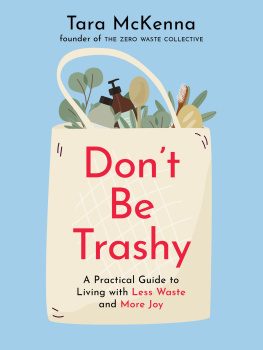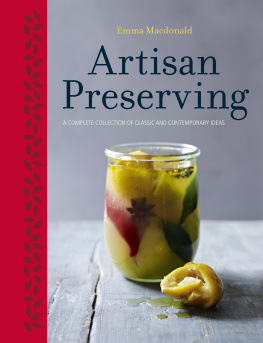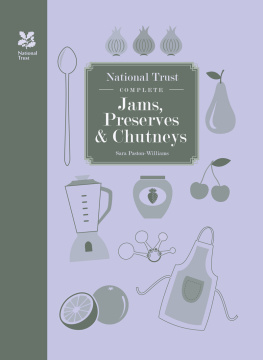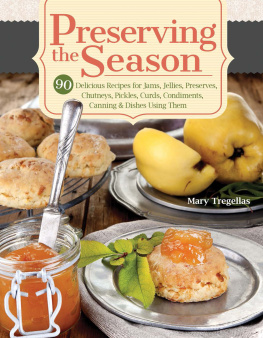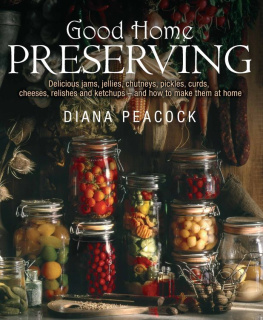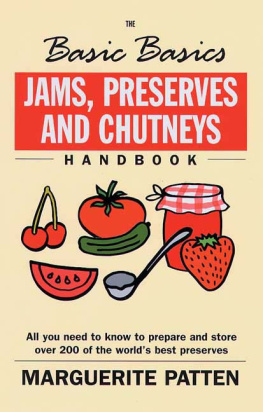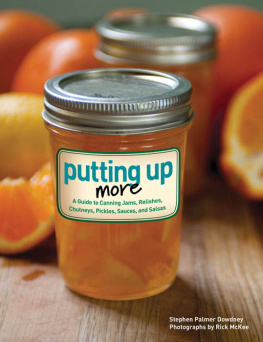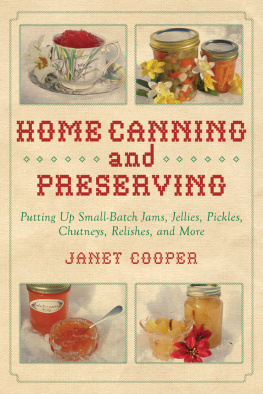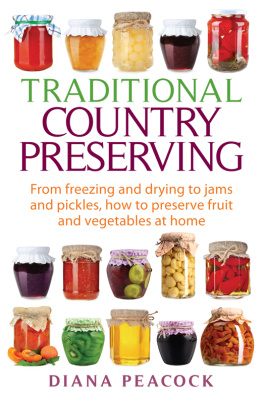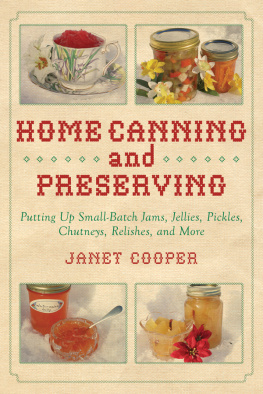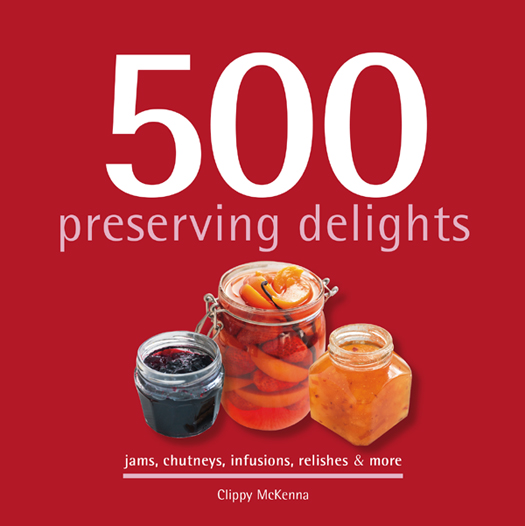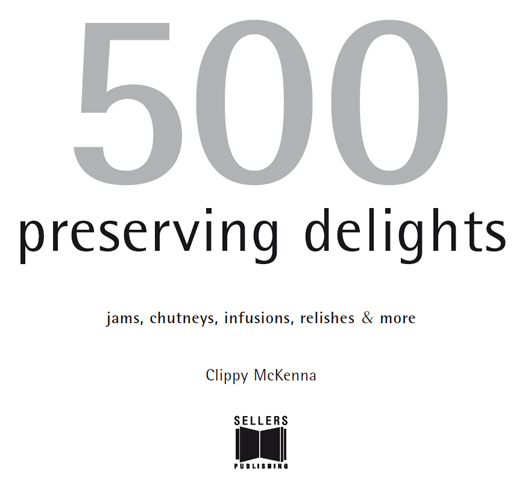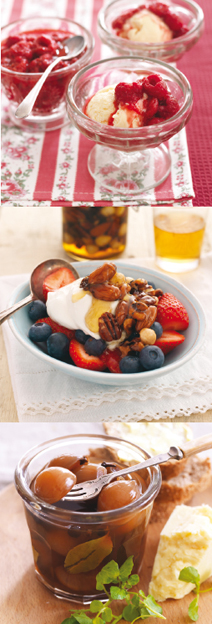A Quintet Book
Published by Sellers Publishing Inc.
161 John Roberts Road, South Portland, Maine 04106
Visit our Web site:
e-ISBN: 978-1-4162-4553-7
500 Preserving Delights copyright 2015 Quintet Publishing Limited. All rights reserved under International and Pan-American copyright conventions. By payment of the required fees, you have been granted the nonexclusive, nontransferable right to access and read the text of this e-book onscreen. No part of this text may be reproduced, transmitted, downloaded, decompiled, reverse engineered, or stored or introduced into any information storage and retrieval system, in any form, by any means, whether electronic or mechanical, now known or hereinafter invented, without the express written permission of Sellers Publishing, Inc. e-books.
January 2015
This book was designed and produced by
Quintet Publishing Limited
4th Floor, Sheridan House
114-116 Western Road
Hove, East Sussex
BN3 1DD
Food Stylist: Maud Eden
Photographer: Jon Whitaker
Art Director: Michael Charles
Managing Editor: Emma Bastow
Publisher: Mark Searle
introduction
People have always preserved food in various forms; from the simplest of dried meats to the elaborate sugared fruits of the Renaissance era royals, from beer and wine to jewel-like jars of jams and jellies, preserving is the only way to keep the bounty of a harvest for more than a few days. A bright marmalade enlivens even the darkest winters breakfast, and a belly-warming sloe gin is always a welcome sight on a cold evening.
In ancient times, fermenting, pickling in vinegar, and air-drying were the most prevalent methods of preserving, though the first known book of recipes included recipes for jams and preserves and was written 2000 years ago by a Roman gastronome, Marcus Gavius Apicius. A huge leap forward came with the mass-production of sugar in the late sixteenth century, and the invention of the vacuum seal in the eighteenth century started a new boom in homemade jams, pickles, and liqueurs.
A recent resurgence in artisan jam- and preserve-making has paved the way for companies, such as Clippys, to make jams and preserves that are based on more fresh fruit and less sugar. See www.clippys.com for more information. And a revival of home-grown produce and preserving is a welcome development!
This book provides all of the recipes you could need to preserve garden or market produce. Enjoy picking out recipes to make, and make sure to read this introductory section before you start; its packed with tips and guidance to make sure you make the perfect preserve every time.
before you start
Measures in this book are given in either cups or ounces, and it is recommended that fruit quantities are always followed in weight; it is far more accurate and will give a consistent final product.
Always follow the recipes exactly; they are carefully calibrated to ensure a good set and a long-lasting preserve. Likewise, its not advised to double up recipes; if you have more fruit to use up, make two batches.
It really is essential to follow very basic, but very strict hygiene rules in order to prevent the spoilage of your preserves.
Make sure that you have a spotlessly clean kitchen environment; this also extends to your equipment and utensils.
Always wash hands before and during preparation to minimize bacteria and mold.
Always wear appropriate clothing; this includes long sleeves and covered shoes (not sandals).
Always use fresh fruit and vegetables without any blemishes; this extends to spices and herbs as well.
The filling of jars can be particularly hazardous; please make sure you are aware of your surroundings. Use gloves and a jam funnel. While children can be involved in the preparing of fruit and vegetables, its best to keep young children at a safe distance while hot pans of boiling sugar are around, and while bottling or canning.
Some preserves reach very high temperatures; therefore, for your own safety please make sure that you remember the basic rules of the kitchen. The fastest relief comes from cold running water and lots of it! Always seek medical attention for more serious burns.
Before you start to can, make sure you have plenty of sterilized jars ready. Always sterilize more jars than you think youll need.
preserving techniques
There are many techniques for preserving foods, such as smoking, drying, and curing. In this book the recipes focus on preserving with sugar, vinegar, oil, and alcohol. Each preserving technique can be used separately or together to produce delightful preserved concoctions.
sugar
The most widely used fruit preserving technique is with sugar. Sugar is used in jams, marmalades, jellies, chutneys, relishes, and pickles. When preserving, sugar is an integral part of the process; not only does it preserve the product, it also influences the final flavor of the preserve. The general preserving rule of thumb is to use equal amounts of sugar to fruit, but for certain recipes this is not the case. Most of my sugar-based recipes contain more fruit and less sugar, using fruits high in pectin to set the preserve instead.
refined sugars
I tend to use white refined granulated sugar (which is highly processed, as the natural molasses is stripped from the sugar cane or beet) for jams, jellies, curds, liqueurs, and cordials mainly due to the large crystals, which dissolve quickly and produce lovely silky preserves. When I first started making sweet preserves, I always used unrefined raw organic cane sugar, but I noticed after a period of time that the fresh fruit flavor was masked by the caramel flavor; it also changed the color so it wasnt bright and vibrant. I dont use jam sugar (sugar with added pectin); it tends to be quite tricky to use.
unrefined sugars
Brown sugars such as demerara, muscovado, and molasses are wonderful for imparting a more robust flavor to your preserves, and they work exceptionally well in marmalades, chutneys, relishes, and some condiments. Due to the manufacturing process, unrefined sugars retain most, if not all, their molasses flavor.
vinegar
When preserving with vinegar, its really important to choose vinegars that have an acidity level of at least 5 percent; you can find this on the label. This will help you preserve and store your creations correctly; the undesirables (micro-organisms) tend not to save in this acidic environment. Within this book youll notice that I use different types of vinegars; each one imparts different flavors, depending on what youre looking for, whether robustness, sharpness, or sweet and sour.
cider vinegar
Derived from apples, this is one of my favorite vinegars, and I tend to use this the most. Its not as expensive as wine vinegars, and it works really well in savory jellies, pickles, relishes, and most chutneys.


